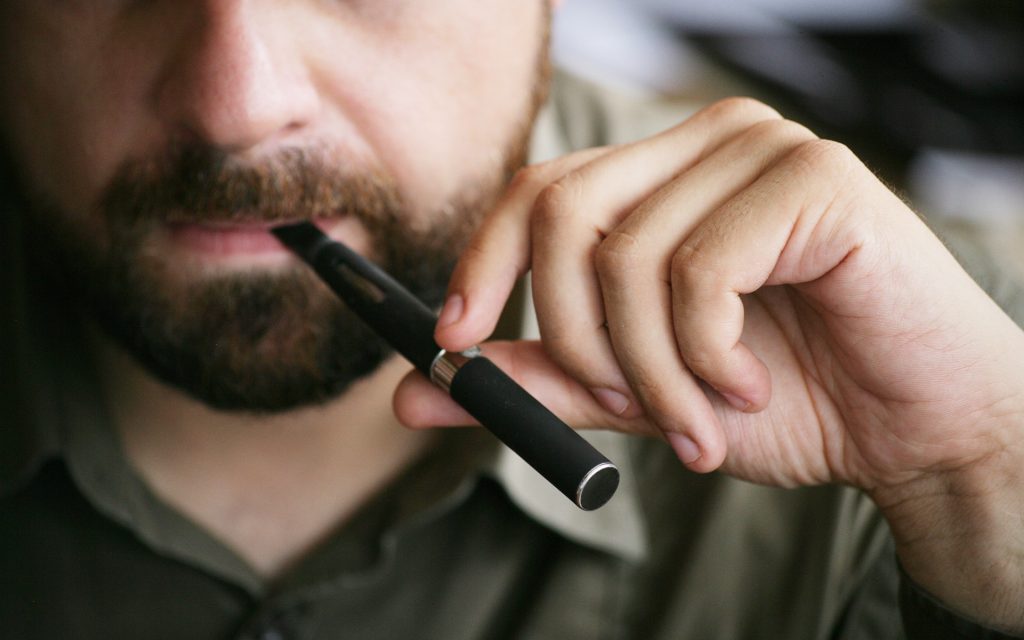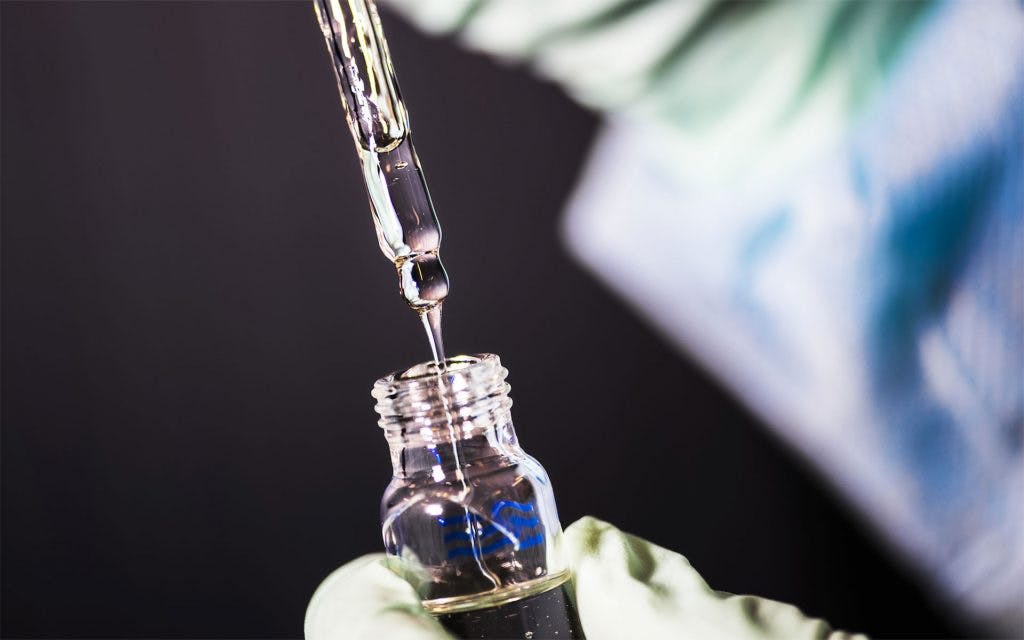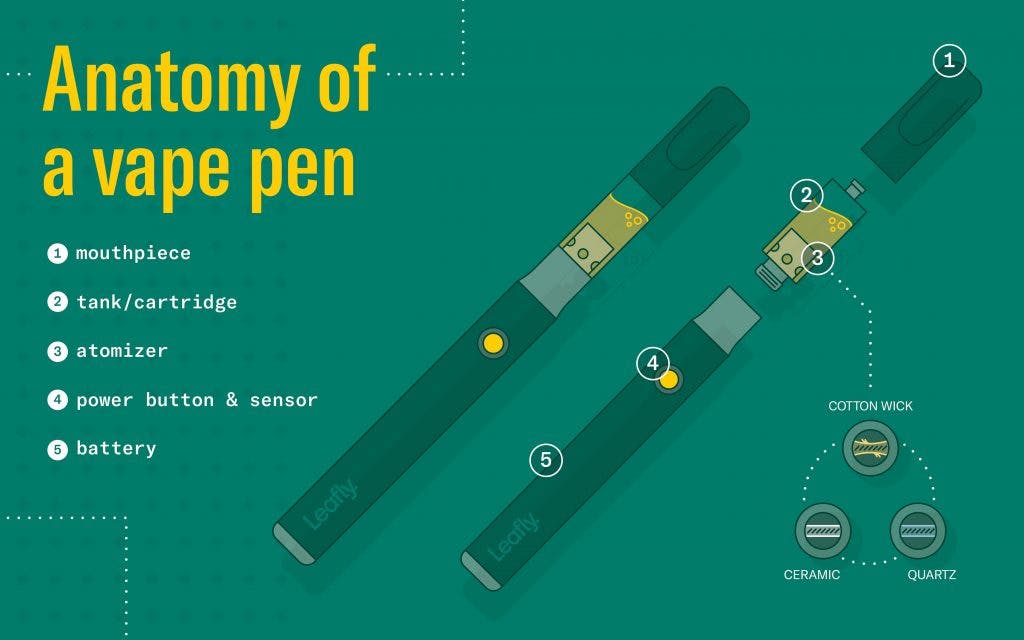
Science about vaporizing marijuana oil and concentrates
Mind & Matter is a monthly column by Nick Jikomes, PhD, Leafly’s Director of Science and Innovation.
Physics and chemistry between vaping and smoking

In both vaping and smoking, high temperatures are applied to a material to transform it from a solid or liquid into an aerosol that allows it to be inhaled. The difference between vaping and smoking is the temperature. At relatively low temperatures, molecules simply vaporize and pass from the solid or liquid phase into the aerosol. When things get hot enough, combustion occurs. This results in the same molecules not only evaporating, but also turning into other things (e.g. THCA → THC). It can also cause them to break down into other things, including harmful byproducts. When you smoke something by applying a flame or very hot heating element to marijuana, you inhale a mixture of what you want (vaporized cannabinoids, terpenes, etc.) along with breakdown byproducts.
Even more
What is cannabis vaping and how does it work?
The vaporization temperature required to make something inhalable depends on the specific molecule you are talking about as well as the physical substrate it resides in. For example, the vaporization temperature for THC in dried flower is different than in concentrated oil, and can also vary somewhat between different types of concentrates. In general, the temperature required to vaporize THC and other cannabinoids in flower is lower, around 200 degrees Celsius. Many concentrate vaporizers use temperatures ranging from around 400 degrees Fahrenheit on the low end to 1,000 degrees Fahrenheit or more. Concentrates are also commonly consumed with very hot heating elements, causing the product to burn.
Vaping vs. Smoking: How Do They Affect the Experience?

Let’s say you are vaping a cannabis concentrate at a relatively low temperature (<300°C). Will the experience be different than smoking the same amount of the same product using very high temperatures at which combustion occurs?
Yes.
For one thing, the smoke resulting from the material being burned will likely contain particles that are a different size from the vapor, affecting their ability to be absorbed by the lungs. Additionally, much of the smoke (and therefore THC) is lost to the environment. Every time someone coughs or exhales a large puff of smoke, they are losing THC. Other things being equal, the smoke contains less THC simply because some of it breaks down into other compounds (which you also inhale). In a 2018 study examining the effects of smoked and vaporized marijuana flower, vaporization tended to result in higher levels of intoxication compared to smoking when the same amount of material was held constant. This has been interpreted to mean that vaporizers are a more efficient way of delivering THC to the body than traditional smoked preparations.
Related
The best vaporizers for cannabis flowers
Consumers often report that the high feels different from vaped or smoked cannabis and often prefer the subjective effects of smoking. Assuming this is true even when consuming the exact same amount of THC. What could be the explanation for this? One answer might be that marijuana smoke can contain many other things not found in vapor. A key difference between marijuana smoke and vape is that smoke typically has higher levels of carbon monoxide, which “displaces” oxygen for access to red blood cells. This leads to mild hypoxia: less oxygen is delivered to body tissues. In my recent conversation with Dr. Echo Rufer, a toxicologist at PAX, hypothesized that the mild hypoxia associated with smoking could result in different subjective effects than vaporized cannabis, which some consumers may prefer. Further testing is required to determine if this hypothesis is correct.
However, higher temperatures are more likely to produce more harmful thermal degradation by-products.
The taste also differs when vaping versus smoking and when vaping at one temperature versus another. With cannabis, much of the flavor comes from terpenes, small aromatic compounds found in many products. Terpenes vaporize at lower temperatures than cannabinoids. Because of this, the ratio of terpenes to cannabinoids changes across the vaping temperature range. Lower temperatures tend to result in a higher terpene-to-cannabinoid ratio and stronger “terp flavor”. Whether this is desirable or not depends on your own taste. However, higher temperatures are more likely to produce more harmful thermal degradation by-products. If you’re using a vaporizer with adjustable temperature, it’s worth trying different temperatures to see how it affects the flavor and “smoothness” of the vapor.
Health Risks of Vaping vs. Smoking
Provided your marijuana product does not contain any harmful additives and your device is properly designed (see below), vaporization produces far fewer potentially harmful by-products compared to combustion (smoking). The lower the temperature, the less likely you are to inhale anything beyond what is contained in your source material. Smoke is definitely more harmful than vapor in terms of the amount and variety of potentially harmful compounds you inhale.
The composition of tobacco smoke has been extensively studied and over 90 harmful and potentially harmful components have been identified. These include carcinogens, which is why smoking tobacco carries an increased risk of cancer. Although nicotine is the psychoactive and addictive component of tobacco smoke, it is actually the harmful by-products of burnt plant matter that are responsible for tobacco smoke’s carcinogenicity.
Related
Here’s how to buy and review vape carts
There are also purely physical considerations between vapor and smoke in terms of lung health. Smoke is hotter and denser than vapor, which means it’s more irritating to the lungs and physically damaging (assuming your vaporized product doesn’t contain any additional harmful additives).
Important caveats aside, vaporizing almost always poses fewer health risks than smoking.
additives and diluents

Compared to nicotine products, cannabis oil has one very useful property: it can be inhaled as is, without the need for diluents or synthetic flavor additives. Most nicotine vape products contain around 1-5% nicotine. The bulk of the product consists of a diluent that serves to dilute the nicotine to these levels. Nicotine vapor can be highly irritating if the nicotine concentration is too high and cause undesirable effects, which is why diluents are used. Nobody wants to vape a nicotine product with 90%, 50% or even 20% nicotine.
Cannabis concentrates are often very high in THC, with concentrations in excess of 75% and often as high as 95-99% THC (e.g. distillate). Cannabis oil simply does not need to be diluted like nicotine to avoid severe physical irritation and side effects or to achieve the desired psychoactive effects. Diluents are sometimes used in cannabis oil, but this is usually done to maintain a consistent THC level across product batches. These cannabis diluents are used in much lower concentrations than nicotine vape products and typically consist of herbal terpenes found in raw cannabis oil.
Related
What is cannabis vaping and how does it work?
Occasionally you will find cannabis oils that contain other diluents such as B. PG/VG (commonly used in nicotine vape products). However, cannabinoids vaporize at higher temperatures than nicotine, so it is possible that vaporizing cannabis oil containing these diluents will produce vapor with potentially harmful by-products.
It is important to emphasize that illegal cannabis vape products should be avoided altogether. These may contain diluents or additives that can be very harmful or even fatal. The EVALI public health crisis a few years ago involved illegally marketed cannabis vape products containing vitamin E acetate, resulting in a number of deaths (see my conversation with toxicologist Dr. Echo Rufer for more details ).
Hardware Considerations for Vaping

There are also hardware considerations for vaping cannabis. An important design feature is the air path of the cannabis vapor, which should never pass over the device’s internal electronic components. These electronic components may contain heavy metals or residual solvents used in the manufacturing process. Your cannabis vapor can pick up these harmful substances when it comes into contact with the device’s internal components. Luckily, most reusable cannabis vaporizers from well-known brands are designed so that the air path does not pass through the internal components of the device. However, you need to look at the design specs to be sure. It seems to be more common to see disposable vaporizer devices where the airway comes in contact with internal components.
To learn more about vaporization, smoking, and the topics covered in this article, watch my conversation with Dr. Echo caller to:

Post a comment: